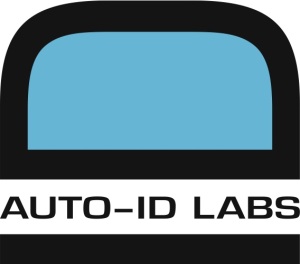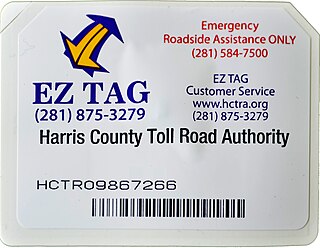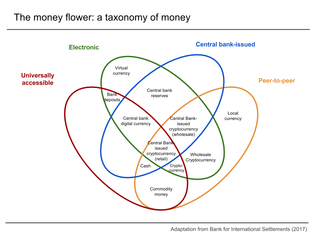
The markka, also known as the Finnish mark, was the currency of Finland from 1860 until 28 February 2002, when it ceased to be legal tender. The markka was divided into 100 pennies, abbreviated as "p". At the point of conversion, the rate was fixed at €1 = 5.94573 mk.

In economics, cash is money in the physical form of currency, such as banknotes and coins.

The Australian dollar is the official currency and legal tender of Australia, including all of its external territories, and three independent sovereign Pacific Island states: Kiribati, Nauru, and Tuvalu. In April 2022, it was the sixth most-traded currency in the foreign exchange market and as of Q1 2024 the sixth most-held reserve currency in global reserves.
Radio-frequency identification (RFID) uses electromagnetic fields to automatically identify and track tags attached to objects. An RFID system consists of a tiny radio transponder called a tag, a radio receiver, and a transmitter. When triggered by an electromagnetic interrogation pulse from a nearby RFID reader device, the tag transmits digital data, usually an identifying inventory number, back to the reader. This number can be used to track inventory goods.

Security printing is the field of the printing industry that deals with the printing of items such as banknotes, cheques, passports, tamper-evident labels, security tapes, product authentication, stock certificates, postage stamps, and identity cards. The main goal of security printing is to prevent forgery, tampering, or counterfeiting. More recently many of the techniques used to protect these high-value documents have become more available to commercial printers, whether they are using the more traditional offset and flexographic presses or the newer digital platforms. Businesses are protecting their lesser-value documents such as transcripts, coupons and prescription pads by incorporating some of the features listed below to ensure that they cannot be forged or that alteration of the data cannot occur undetected.

The Auto-ID Labs network is a research group in the field of networked radio-frequency identification (RFID) and emerging sensing technologies. The labs consist of seven research universities located on four different continents. These institutions were chosen by the former Auto-ID Center to design the architecture for the Internet of Things together with EPCglobal. The federation was established in 1999; the network they have developed is at the heart of a proposal sponsored by EPCglobal and supported by GS1, GS1 US, Wal-Mart, Hewlett-Packard, and others to use RFID and the Electronic Product Code (EPC) in the identification of items in the supply chain for companies. The areas of expertise range from hardware to software to business research related to RFID.

The dong has been the currency of Vietnam since 3 May 1978. It is issued by the State Bank of Vietnam. The dong was also the currency of the predecessor states of North Vietnam and South Vietnam, having replaced the previously used French Indochinese piastre.

Touch 'n Go is a contactless smart card system used for electronic payments in Malaysia. The system was introduced in 1997 and is widely used for toll payments on highways, public transportation, parking, and other services. The card is equipped with a radio-frequency identification (RFID) chip that allows users to make payments by simply tapping the card on a reader device. Touch 'n Go cards can be reloaded with funds either online or at designated reload kiosks. The system has become a popular and convenient way for Malaysians to make cashless transactions.

EZ TAG is an electronic toll collection system in Houston, Texas, United States, that allows motorists to pay tolls without stopping at toll booths. Motorists with the tags are allowed to use lanes reserved exclusively for them on all Harris County Toll Road Authority (HCTRA) roads. As of late 2003, the EZ TAG can also be used on all lanes of tolled roadways in Texas that accommodate electronic toll collection.

A microchip implant is an identifying integrated circuit placed under the skin of an animal. The chip, about the size of a large grain of rice, uses passive radio-frequency identification (RFID) technology, and is also known as a PIT tag. Standard pet microchips are typically 11–13 mm long and 2 mm in diameter.

Digital currency is any currency, money, or money-like asset that is primarily managed, stored or exchanged on digital computer systems, especially over the internet. Types of digital currencies include cryptocurrency, virtual currency and central bank digital currency. Digital currency may be recorded on a distributed database on the internet, a centralized electronic computer database owned by a company or bank, within digital files or even on a stored-value card.

The ruble, rouble or rubel is the currency of Belarus. It is subdivided into 100 kopecks.

An ear tag is a plastic or metal object used for identification of domestic livestock. If the ear tag uses Radio Frequency Identification Device (RFID) technology it is referred to as an electronic ear tag. Electronic ear tags conform to international standards ISO 11784 and ISO 11785 working at 134.2 kHz, as well as ISO/IEC 18000-6C operating in the UHF spectrum. There are other non-standard systems such as Destron working at 125 kHz. Although there are many shapes of ear tags, the main types in current use are as follows:
Japanese currency has a history covering the period from the 8th century CE to the present. After the traditional usage of rice as a currency medium, Japan adopted currency systems and designs from China before developing a separate system of its own.
Produce traceability makes it possible to track produce from its point of origin to a retail location where it is purchased by consumers.
A human microchip implant is any electronic device implanted subcutaneously (subdermally) usually via an injection. Examples include an identifying integrated circuit RFID device encased in silicate glass which is implanted in the body of a human being. This type of subdermal implant usually contains a unique ID number that can be linked to information contained in an external database, such as identity document, criminal record, medical history, medications, address book, and other potential uses.

Impinj, Inc. is a manufacturer of radio-frequency identification (RFID) devices and software. The company was founded in 2000 and is headquartered in Seattle, Washington, United States. The company was started based on the research done at the California Institute of Technology by Carver Mead and Chris Diorio. Impinj currently produces EPC Class 1, Gen 2 passive UHF RFID chips, RFID readers, RFID reader chips, and RFID antennas, and software applications for encoding chips, and gathering business intelligence on RFID systems.
Chipless RFID tags are RFID tags that do not require a microchip in the transponder.
Various schools have been using radio-frequency identification technology to record and monitor students.

On 8 November 2016, the Government of India announced the demonetisation of all ₹500 and ₹1,000 banknotes of the Mahatma Gandhi Series. It also announced the issuance of new ₹500 and ₹2,000 banknotes in exchange for the demonetised banknotes. Prime Minister Narendra Modi said that this decision would curtail the shadow economy, increase cashless transactions and reduce the use of illicit and counterfeit cash to fund illegal activity and terrorism.













